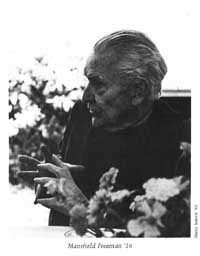General History
In 1976, the late David Titus, Professor of Government and East Asian Studies, researched and wrote an account of the earliest interactions between Wesleyan and East Asia — which begins very early indeed, some five years after the University's founding in 1831.
In addition, Professor Titus compiled lists of early courses and lectures on East Asian topics.
Here is a chronology of events related to East Asian Studies at Wesleyan.
Much of the early contact between Wesleyan and East Asia was mediated by missionaries. Wesleyan was one of eleven colleges and universities participating in the American Context of China's Christian Colleges project, which was directed by Professor (Emerita) Ellen Widmer of Wesleyan's Asian Languages and Literatures Department. The project's website contains a great deal of Wesleyan-specific information, including many full-text articles from the Wesleyan Argus student newspaper from 1900-1950.
The Freeman Legacy
| The development of East Asian Studies at Wesleyan since the mid-1970s has been possible thanks to the visionary support of Mansfield Freeman ('16), his son Houghton Freeman ('43), and the Freeman Foundation.
Collected here are selections from a feature article on the Freemans from a past Wesleyan Alumni Magazine.
In addition, please see the information on the Mansfield Freeman Lecture Series, inaugurated in 1976. |
 |
Dr. Paul Chih Meng
The largest and most significant donation to the CEAS collection was given by Dr. Paul Chih Meng, in whose honor we have dedicated the Student Reading Lounge on the first floor.
Dr. Meng, a seventy-third generation descendent of the Confucian philosopher Mencius, received a traditional education in the Confucian Classics in Peking. He went on to pursue his higher education in the United States. Appreciative of what is best in both Chinese and American culture, Dr. Meng has played a significant role in achieving better understanding between these two countries. During his long educational career, he has served as Director of the China Institute in America (until 1967) and is the author of China Speaks (1932) and Chinese-American Understanding: A Sixty Year Search (1981).
Dr. Meng’s life-long commitment to cross-cultural understanding is also expressed through the Chinese calligraphy in the Meng reading room. Displayed above the fireplace mantle are the two character Da Tong, “Great Unity,” which Dr. Meng has interpreted as “The Great Common Foundation of all under Heaven—on which are based all great religions and moralities.” Da Tong, the ideal of a harmonious integration of disparate values, is a recurrent theme in Chinese philosophy. This theme may also be seen in the quotation from Mencius inscribed on the Meng plaque. The six characters suggest a guideline for the wise person who would “live in the world’s spacious mansion (guang zhu), stand upright in the world (zheng wei), and walk on the Great Way (da dao).” For a transcription and translation of the whole inscription, click here: http://www.wesleyan.edu/ceas/about/history.html.
